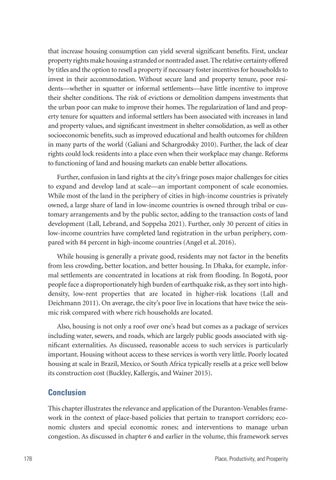that increase housing consumption can yield several significant benefits. First, unclear property rights make housing a stranded or nontraded asset. The relative certainty offered by titles and the option to resell a property if necessary foster incentives for households to invest in their accommodation. Without secure land and property tenure, poor residents—whether in squatter or informal settlements—have little incentive to improve their shelter conditions. The risk of evictions or demolition dampens investments that the urban poor can make to improve their homes. The regularization of land and property tenure for squatters and informal settlers has been associated with increases in land and property values, and significant investment in shelter consolidation, as well as other socioeconomic benefits, such as improved educational and health outcomes for children in many parts of the world (Galiani and Schargrodsky 2010). Further, the lack of clear rights could lock residents into a place even when their workplace may change. Reforms to functioning of land and housing markets can enable better allocations. Further, confusion in land rights at the city’s fringe poses major challenges for cities to expand and develop land at scale—an important component of scale economies. While most of the land in the periphery of cities in high-income countries is privately owned, a large share of land in low-income countries is owned through tribal or customary arrangements and by the public sector, adding to the transaction costs of land development (Lall, Lebrand, and Soppelsa 2021). Further, only 30 percent of cities in low-income countries have completed land registration in the urban periphery, compared with 84 percent in high-income countries (Angel et al. 2016). While housing is generally a private good, residents may not factor in the benefits from less crowding, better location, and better housing. In Dhaka, for example, informal settlements are concentrated in locations at risk from flooding. In Bogotá, poor people face a disproportionately high burden of earthquake risk, as they sort into highdensity, low-rent properties that are located in higher-risk locations (Lall and Deichmann 2011). On average, the city’s poor live in locations that have twice the seismic risk compared with where rich households are located. Also, housing is not only a roof over one’s head but comes as a package of services including water, sewers, and roads, which are largely public goods associated with significant externalities. As discussed, reasonable access to such services is particularly important. Housing without access to these services is worth very little. Poorly located housing at scale in Brazil, Mexico, or South Africa typically resells at a price well below its construction cost (Buckley, Kallergis, and Wainer 2015).
Conclusion This chapter illustrates the relevance and application of the Duranton-Venables framework in the context of place-based policies that pertain to transport corridors; economic clusters and special economic zones; and interventions to manage urban congestion. As discussed in chapter 6 and earlier in the volume, this framework serves 178
Place, Productivity, and Prosperity

